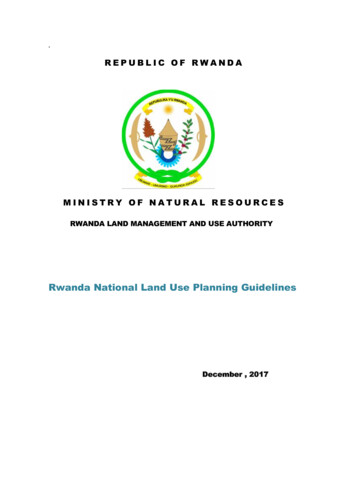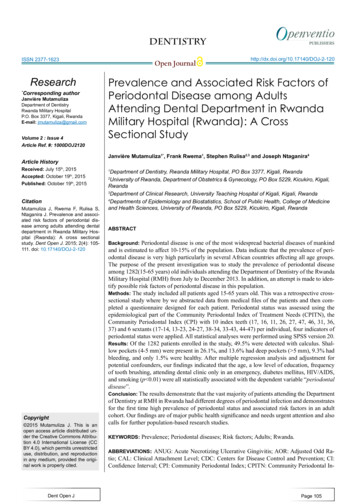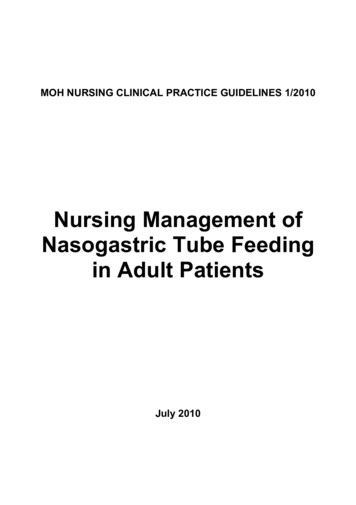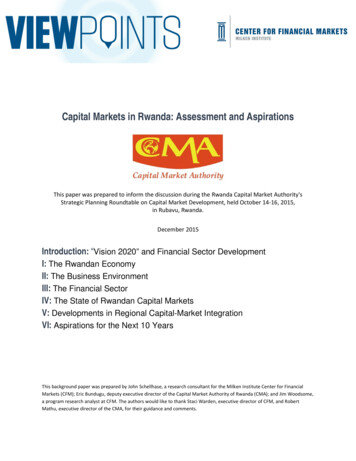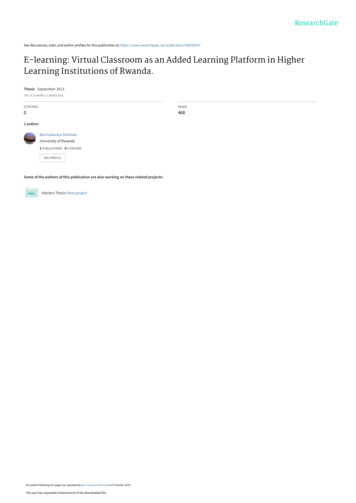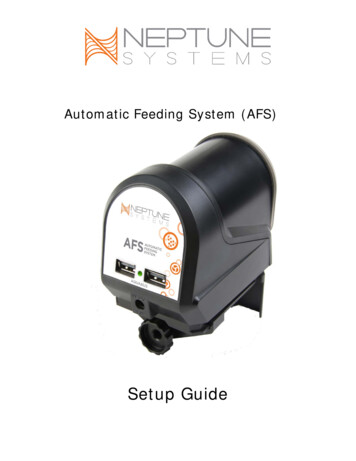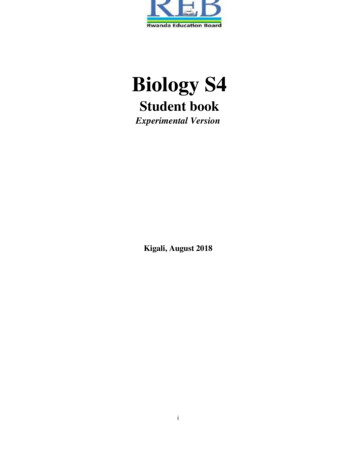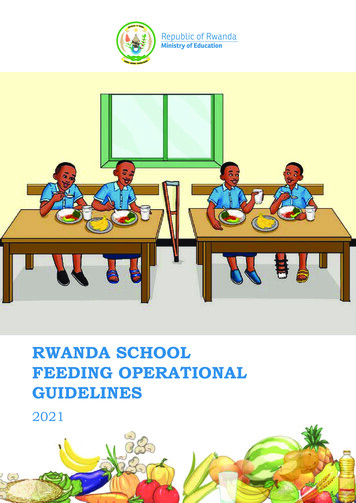
Transcription
RWANDA SCHOOLFEEDING OPERATIONALGUIDELINES2021
School Feeding Operational GuidelinesAcknowledgementThe Ministry of Education would like to thank the Government's main partner inschool feeding, the World Food Programme, for technical and financial support inadvancing a high-quality universal school feeding programme in Rwanda since2002 and particularly in the development, review and validation process of theseSchool Feeding Operational Guidelines.Additionally, the Ministry of Education would like to appreciate the support andcontribution of all members of the School Feeding Technical Working Group whohave also contributed to the development of the guidelines in addition to those whosupport school feeding and the education sector in general.ii
School Feeding Operational GuidelinesTable of ContentForeword . iAcknowledgement . iiTable of Content . iiiList of Annexes .viList of Figures.viiList of Tables . viiiList of Abbreviations .ix1.Introduction . 11.1.Background . 11.2.Potential benefits of School Feeding . 11.3.Prevailing policy context. 41.4.Main features of the Comprehensive National School Feeding Policy . 61.5.Structure of the guide . 81.6.How to use this guide . 92.Healthy and Nutritious School Meals.112.1.General requirements to school meals .112.2.The food basket for school meals in Rwanda .122.2.1.Nutrient requirements .122.2.2.Dietary diversity and food groups.132.2.3.Proposed ‘base meal’ .142.2.3.1.Base meal for day schools .152.2.3.2.Children with special requirements .172.2.3.3.Base menu for boarding schools .182.2.4.Substitution .192.2.5.Costs .213.Budgeting, Planning and Procurement .243.1.Adequate budgeting for the programme .253.2.Ensuring the availability of required funds at the right time .283.3.Procurement of food .30iii
School Feeding Operational Guidelines3.3.1. Principles governing school feeding special food procurementguidelines .303.3.2. Step-by-step guide for Special food procurement guidelines underthe NSFP.344.Food management at school.444.1.Inspection of food quality and safety at school.444.1.1.Overview of control methods and control points at school .444.1.2.Food in containers .454.1.3.Food not in containers .484.2.Food storage at school .484.2.1.Physical conditions of a storeroom.484.2.2.Use of a storeroom .514.2.3.Maintenance of a storeroom .524.3.Accounting for food at school.534.3.1.Reception and food stacking .534.3.2.Handing out food to cooks .544.3.3.Food stock control .564.3.4.Food register.584.3.5.Looking ahead .595.How to Prepare and Serve Healthy and Nutritious School Meals .605.1.Cooks.605.1.1.Requirements for cooks .605.1.2.Daily preparation and hygienic behaviour of cooks .615.1.3.The management of cooks.625.1.4.The number of cooks .625.1.5.Payment of cooks .635.2.Requirements for kitchens .645.3.Calculating food quantities for daily meals .665.4.Control of food quality by cooks.685.5.Preparation of meals .695.6.Preparation of pupils .705.7.Requirements for toilets and handwashing facilities .725.8.Serving of meals .74iv
School Feeding Operational Guidelines5.9.Eating of meals .755.10. After the meal .756.How the programme will monitor and report on its activities and results776.1.Transparent and accountable use of resources .786.2.What has the programme done and provided? .806.3.What has the programme achieved? .816.4.Sharing results and learning.837.How the programme is governed and managed .857.1.Overview of the governance structure of the programme .857.2.The National School Feeding Steering Committee .867.3.The School Feeding Technical Working Group .897.4.Multi-sectoral coordination at decentralized levels .937.5.Implementing actors and their respective tasks. .95v
School Feeding Operational GuidelinesList of ex1: Estimated required daily macro- and micronutrient . 1062: Level of macro- and micronutrients provided by base meal .1073: National fortification requirements . .1094: Substitution tables for proposed base meals . .1115:Template for an agreement between SFCs and cooks . . .1136: Standard Design for School Feeding Kitchens 1147: Checklist for school kitchens . 1198: Template for a school-meals request for quotations / notice .1229:Template for a school-meals tendering document .12410: Template for the review of bids .12711: Template for an award notice.13012:Template for a bid evaluation report.13113: Template for a food call forward.13514: Template for a food receipt .13615: Checklist for storerooms .13716: Food management sheet .14017: Resource management sheet .14118: Template for an Annual School Feeding Report .14219: Template contract with supplier in Kinyarwanda Annual School 144vi
School Feeding Operational GuidelinesList of FiguresFigure 1: Illustration of the proposed base meal (primary) . 15Figure 2: Anatomy of wholegrains . 17Figure 3: Nutritional requirements of adolescent girls and boys . 18Figure 4: Food items with good agricultural potential in Rwanda’s provinces . 20Figure 5: Overview of the flow of funds, food and information . 24Figure 6: Timing of the planning, funding and procurement process . 28Figure 7:The process of NSFP food procurement . 344Figure 8:Generic lay-out of a spacious food storeroom . 49Figure 9:Examples of pallets or poles under food stacks. 52Figure 10 : Illustration of good food stacks . 54Figure 11: The Food Management Sheet (extract for one food item) . 59Figure 12: Food safety temperatures .70Figure13 :Efficient handwashing 71Figure 14: NSFP Resource Management Sheet . 79Figure 15: Overall governance structure of the NSFP . 85Figure 16: Overview of NSFP implementation actors . 944vii
School Feeding Operational GuidelinesList of eTableTable1: Daily nutrient requirements to be provided through school meals .132: Food groups from which meals can be composed .143: Base meal for day schools .154: Base menu for boarding schools .195: Example for a substitution table .216: Food calculation table (excerpt) .357: Calculations of required food budgets per term and school year .368: Most relevant control methods at different control points at school .459: Physical inspection of food . . 4810: Considerations for latrines and school feeding handwashing facilities7311: Overview of indicators to be monitored and their use . .78viii
School Feeding Operational GuidelinesList of AbbreviationsBMIBody Mass IndexCNSFPComprehensive National School Feeding Policy (2019)CSBCorn-Soy Blend, fortifiedDEODistrict Education OfficerDFIDUnited Kingdom Department for International DevelopmentDSFCDistrict School Feeding CommitteeEMISEducation Management Information SystemESExecutive SecretaryFAOUnited Nations Food and Agricultural OrganisationHGSFHome-Grown School FeedingIFMISIntegrated Financial Management Information SystemJADFJoint Action Development ForumJICAJapanese International Cooperation AgencyJRESJoint Review of The Education SectorMIGEPROFMinistry of Gender and Promotion of the FamilyMINAGRIMinistry of Agriculture and Animal ResourcesMINALOCMinistry of Local GovernmentMINECOFIN Ministry of Economy and FinanceMINEDUCMinistry of EducationMINEMAMinistry of Emergency ManagementMINICOMMinistry of CommerceMININFRAMinistry of InfrastructureMINISANTEMinistry of HealthNBANon-Budget AgencyNCDANational Childhood Development AuthorityNSFPNational School Feeding ProgrammeNSF-SCNational School Feeding Steering CommitteePHOPublic Health OfficerRABRwanda Agricultural BoardRCARwanda Cooperative AgencyRDARecommended Dietary AllowanceREBRwanda Basic Education Boardix
School Feeding Operational GuidelinesRFDARwanda Food and Drugs AuthorityRPPARwanda Public Procurement AuthorityRTBRwanda TVET BoardRWFRwandan FrancsSDMSSchool Data Management SystemSFCSchool Feeding CommitteeSFCTSchool Feeding Coordination TeamSF-TWGSchool Feeding Technical Working GroupSGASchool General AssemblySNVAssociation of Dutch Volunteer OrganisationsSTCSchool Procurement CommitteeUNICEFUnited Nations Children’s FundUSAIDUnited States Agency for International DevelopmentWASHWater, Sanitation and HygieneWFPUnited Nations World Food ProgrammeWHOWorld Health OrganizationWVIWorld Vision Internationalx
School Feeding Operational Guidelines1. IntroductionThis section provides the background for the National School Feeding Program(NSFP) of Rwanda, briefly describes the generic potential benefits of school feeding,summarizes the prevailing policy context (2020), presents the main features of theComprehensive National School Feeding Policy (CNSFP) of 2019, presents thestructure of this Operational Guideline and finally, explains how to use this guide.1.1. BackgroundSchool feeding has been an important feature in the schools of Rwanda for years.Until recently, it consisted of three separate programmes: The ‘One Cup of Milk per Child’ programme was introduced to reducemalnutrition among Rwandan children, with a specific objective of improvingthe nutrition status of children attending school in order to enhance thedevelopment of their brain capacity and to promote school retention ofchildren attending pre- and primary schools. This programme, which in 2019reached almost 620,000 children, is fully funded by the Government ofRwanda, and managed by the National Childhood Development Authority(NCDA). In public and Government-aided secondary day and boarding schools, theprogramme is community based and parents are primarily responsible toprovide food for their children either in kind or in cash. The Governmentprovides 56 FRW per day per student to supplement parents’ contributions,reaching about 490,000 students. This programme, too, is funded by theGovernment of Rwanda and managed by the Ministry of Education. Finally, WFP’s Home-Grown School Feeding (HGSF) Programme providesdaily meals to primary students in 107 schools in Nyaruguru, Nyamagabe,Rutsiro and Karongi Districts where poverty and food insecurity isconsidered high.In combination, these programmes serve nearly 700,000 students (17.6% coverage,2019 figures). In the Comprehensive National School Feeding Policy, theGovernment has decided as of the school year 2020/21 to provide healthy andnutritious school meals to all students in pre-primary, primary and secondaryschools, integrating all of the above initiatives.The present Operational Guidelines seek to describe in detail how this can beachieved, and what all the involved actors will have to do to make it work.1.2. Potential benefits of School FeedingSchool feeding can have a number of benefits, both for school children themselves,for their households, and for local communities. The four most important benefits1
School Feeding Operational Guidelinesare centred around four main areas, 1 i.e. (1) Education; (2) Health and nutrition;(3) Social protection and gender equality; and (4) Agriculture and derived multipliereffects for local economies. Documented evidence for specific benefits issummarized below for each of the four areas.EducationSchool feeding can promote enrolment, attendance, retention and learning:¾ Based on a study of countries in Sub-Saharan Africa, school feeding hasbeen reported as an impactful intervention for boosting student learning;particularly in Burkina Faso, Kenya and Senegal. 2¾ School feeding programmes can increase enrolment by an average of 9%, 3and reduce the probability of drop-outs by 7.5%. 4¾ School feeding programmes can show positive impact in both schoolparticipation (enrolment, attendance, completion) and learning (scores oncognitive, language and mathematics tests). 5Such improvements at global level are confirmed from Rwanda, where WFP schoolfeeding and complementary literacy activities in selected primary schools fundedby the US Government has led to reading comprehension improvements from 42to 56.8 percent among boys, and from 57 to 62.9 percent among girls, between2016 and 2018; to a reduction of health-related absenteeism from eight percent toless than five percent; 6 and of dropout rates down to less than 1 percent over thesame period. 7A recent study (still only in draft form) indicates that the Home-Grown SchoolFeeding programme implemented in Rwanda since June 2014 in selected districtsof Rwanda with particularly high prevalence of stunting has led to improvedperformance of students in primary school tests. These effects become significantafter at least one year of uninterrupted school feeding, and thereafter continueincreasing with each year that children receive regular meals at school. Forexample, students who are covered by HGSF between 1 and 2 years record highermath and science test scores, approximately 0.14 and 0.22 standard deviationsrespectively, relative to students without any exposure to school feeding; while after2-3 years of school feeding, students score 0.24 and 0.42 standard deviations1234567Bundy, D. e.a., Re-Imagining School Feeding: A High-Return Investment in Human Capital and LocalEconomies, 2018Bashir et al. (2018) Facing Forward: Schooling for Learning in Africa. Washington, DC: World Bank.p.127-133Snilstveit et al. in Chapter 12, Bundy et al. (2018) Re-imagining School Feeding: A High-ReturnInvestment in Human Capital and Local Economies, Disease Control Priorities 3, v. 8Bundy et al. (2018) Optimizing Education Outcomes: High-Return Investments in School Health forIncreased Participation and Learning. Disease Control Priorities, Vol 1. World Bank Group.Snilstveit et al. (2015) Interventions for Improving Learning Outcomes and Access to Education in Lowand Middle-Income Countries: A Systematic Review. Systematic Review 24, International Initiative forImpact Evaluation (3ie), in Bashir et al. (2018) Facing Forward: Schooling for Learning in Africa.Washington, DC: World Bank.WFP Rwanda McGovern-Dole FY15 Midterm Evaluation Report, Table 25: Re-estimated values for readingcomprehensionWFP semi-annual data collection survey, October 2019.2
School Feeding Operational Guidelineshigher in science and math test scores respectively relative to students without anyexposure to school feeding. These (preliminary) findings show that not only doesHGSF have a significant positive impact on student performance; they also showthat the return on the (constant) investment in school feeding in terms of studentperformance increase tangibly.Health and nutritionA recent World Bank publication 8 concluded that while the first 1,000 days of lifeare critical for development, much greater investment is also needed in the next7,000 days of middle childhood and adolescence. About 300 million school childrenworldwide suffer from iron-deficiency, causing them to lose some six IQ points perchild; that 66 million school children in low-income countries go to school hungry;and that these conditions translate into the equivalent of between 200 million and500 million schooldays lost owing to ill health each year. 9 School feeding can helpaddress undernutrition, but also help limit the obesity epidemic that oftenaccompanies economic growth; and can help address the “hidden hunger” ofmicronutrient deficiency, by adding micronutrient supplements to food, carefullybalancing diet menus, or providing bio-fortified foods.Independent research has documented several concrete nutrition outcomes ofschool feeding:¾ School feeding programmes can promote macro- and micronutrientadequacy in children’s diets leading to enhanced nutrition and health,decreased morbidity, and increased learning capacities. 10¾ Fortified school meals or snacks consistently reduce anaemia prevalence andimprove micronutrient status (iron, vitamin A, iodine and folate). 11¾ Energy, nutrient and micronutrient intake can be significantly higher andmore adequate and anaemia prevalence can be as much as 10% lower amongchildren participating in a school feeding programme compared to controlgroups. 12Social protection and gender equalityFor many countries, social protection is the main goal of school feeding, providingan income transfer to households of the value of the food distributed. At the sametime, gender equality in education is of crucial importance for the development ofcountries. More specifically:89101112Disease Control Priorities Third Edition, Volume 8, Child and Adolescent Health and Development, WorldBank 2018International Commission on Financing Global Education Opportunity. 2016. “The Learning Generation:Investing in Education for a Changing World.” http://report.educationcommission.org.Jomaa et al. (2011) School feeding programs in developing countries: impacts on children's health andeducational outcomes. Nutrition reviews, 69(2), 83-98Best et al. (2011) Can multi-micronutrient food fortification improve the micronutrient status, growth,health, and cognition of schoolchildren? A systematic review. Nutrition Reviews 69(4): 186-204Abi (2014). School feeding contributes to micronutrient adequacy of Ghanaian schoolchildren. TheBritish Journal of Nutrition 112(6): 1019–333
School Feeding Operational Guidelines¾ School feeding programmes can reduce poverty by boosting income forhouseholds and communities. For families, the value of meals in school isequivalent to about 10 percent of a household’s income. For families withseveral children, that can mean substantial savings. 13¾ The adolescent girls’ strategy in Niger led to an increase of the graduationrate of female students from 32 percent in the 2013-14 school year to 64percent in the 2014-2015 school year. 14¾ There is also a strong correlation between higher levels of education and areduction in child marriages: if all girls in sub-Saharan Africa and South andWest Asia had secondary education, child marriage would fall by 64 %, fromalmost 2.9 million to just over 1 million. 15Agriculture and derived multiplier benefits for local economiesHGSF can help address some of the challenges of agriculture systems in developingcountries, such as distant markets, small farm sizes, dispersed settlements, andhigh postharvest loss. Purchasing food for school feeding from local farmers meansa significant injection of cash into local economies, with positive multiplier effects.¾ In Ghana, a switch to HGSF led to a 33 percent increase in local agriculturalsales and household income. A subsequent survey of 36 low- and middleincome countries (mostly in Sub-Saharan Africa) indicated that localpurchase resulted in the inclusion of more diverse and fresh foods. 16¾ In Nigeria, 6 million locally sourced eggs and 80 tonnes of fish are consumedby 9.2 million schoolchildren across the nation every week, ensuringemployment for 95,000 women. 171.3. Prevailing policy contextThe National Strategy for Transformation 2017-24 (NST-1) is the mainimplementation strategy for the remainder of Rwanda’s Vision 2020 and the firstseven years of its Vision 2050. NST-1 has three main pillars, i.e. (1) Economictransformation; (2) Social transformation; and (3) Transformational governance.The second pillar includes six priority strategies, two of which are eradicatingmalnutrition and to enhance the demographic dividend through improved accessto quality education respectively.The Rwandan Education Sector Policy (2003) – currently under reviewestablishes national education goals and objectives, which provide thephilosophical basis of the role of education in the country and are the basis for1314151617Bundy et al. (2009) Re-thinking School Feeding: Social Safety Nets, Child Development, and theEducation Sector, Directions in Human Development, World Bank Group, (1) xviWFP (2017) Results and Lessons Learned from WFP’s Efforts to Support Adolescent Girls in NigerUNESCO (2014). Sustainable Development Begins with Education.Aurino et al. (2016.) Ghana Home Grown School Feeding Programme. Impact Evaluation Report. PCD,London.Government of Nigeria (2018) Investing in Our People: A Brief on the National Social InvestmentProgrammes in Nigeria, p. 13. www.nhgsfp.gov.ng/4
School Feeding Operational Guidelinesdeveloping all education development programmes. One of its eight specific policyobjectives is ‘to ensure that education is available and accessible to all Rwandesepeople’.The Education Sector Strategic Plan 2018/19 – 2023/24 (ESSP) provides theoverarching framework for a holistic, sector-wide approach to the development anddelivery of education services in Rwanda. It pursues the vision ‘to ensure Rwandancitizens have sufficient and appropriate competencies (skills, knowledge andattitudes) to drive the continued social and economic transformation of thecountry.’ The ESSP is structured around nine strategic priorities, including (1)‘Enhanced quality learning outcomes that are relevant to Rwanda’s social andeconomic development, (with Outcome 1.2 ‘All learners enter primary school at thecorrect age and successfully complete 12 years of basic education’), and (5)‘Increased access to education programmes, especially at Nursery (pre-primary),secondary, TVET and Higher education levels in Rwanda.’ All the nine strategicpriorities will be supported by addressing several cross-cutting issues, including‘School health, hygiene, sanitation, environmental protection and climate change’,by among others developing a national school feeding/gardening programme incollaboration with the Ministry of Agriculture (MINAGRI).The School Health Minimum Package of 2014 promotes nutrition and schoolgardens as important elements of school health and highlights the importance ofadequate infrastructure and equipment for the provision of good nutrition atschool, including kitchens, storerooms, improved stoves, school gardens, fruit treesand kitchen items (pots, pans, plates, etc.).The National Food and Nutrition Policy (NFNP, 2014) seeks to provide an up-todate policy base for nutrition and household food security actions that takes intoaccount national progress and challenges. It recognises food and nutrition asuniversal rights essential for the physical, mental and emotional development ofchildren and the quality of life for adults. It applauds the expansion of schoolfeeding and highlights the importance of the One cup of Milk initiative and of schoolgardens.The draft Rwanda Nutrition Policy has the objectives of (1) achieving optimumnutrition for adequate health for the population of Rwanda, by eliminating all formsof malnutrition in ALL age groups with special attention on pregnant and lactatingwomen, adolescent girls and children below two years; and (2) halting and reversingthe trend of overweight and prevent dietary practices that contribute to noncommunicable diseases especially among Rwandan women, adolescents andchildren. It commends the elaboration of a National School Feeding Policy andStrategy, and the establishment of a national HGSF-programme by MINEDUC –highlighting not least the importance of this programme to stimulate the increaseddemand for nutritious food and good nutrition in the country.The Fourth Strategic Plan for the Transformation of Agriculture 2018-2014(PSTA4) outlines four priority areas, i.e. (1) innovation and extension, (2)productivity and resilience, (3) inclusive markets and value addition, and (4)5
School Feeding Operational Guidelinesenabling environment and responsive institutions. Among its key interventionswith respect to nutrition are the scaling-up of kitchen and school gardens, and ofhome-grown school feeding programs: PSTA 4 will promote, in collaboration withMINEDUC and its agencies as well as other stakeholders, local procurement forschool meals. Farmer cooperatives will be capacitated to become sustainablesuppliers of diversified nutritious foods such as fruits, vegetables, and milk forschool meals, thereby creating a structured and stable market while increasingdiversification of household income. Furthermore, school gardens will be expandedor established to grow micronutrient-dense crops.1.4. Main features of the Comprehensive National School FeedingPolicyIn 2019, the Government of Rwanda updated and approved the draftcomprehensive School Feeding Policy and Strategic Plan (CNSFP) with the goal todeliver a well-organized, decentralized intervention providing school going childrenwith nutritionally adequate, locally produced food thereby reducing povertythrough
School Feeding Operational Guidelines ii Acknowledgement The Ministry of Education would like to thank the Government's main partner in school feeding, the World Food Programme, for technical and financial support in advancing a high-quality universal school feeding programme in Rwanda since
